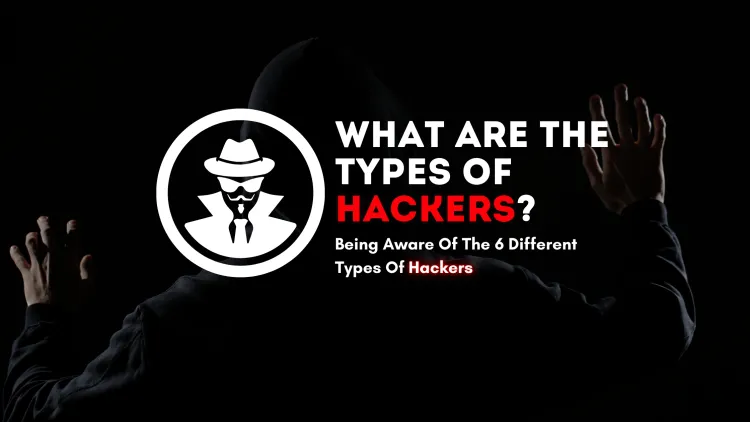What Are the Types of Hackers? Understanding the 6 Different Types of Hackers
Hackers are classified into six types based on their motives and methods: White Hat Hackers protect systems, while Black Hat Hackers exploit them. Gray Hat Hackers walk a fine line, and Script Kiddies are beginners using pre-made tools. Hacktivists hack for political causes, while State-Sponsored Hackers operate on behalf of governments. Understanding these types helps in crafting effective security measures and staying ahead of potential cyber threats.

In the world of cybersecurity, hackers play various roles—some protect, others exploit. Understanding the different types of hackers is crucial to identifying potential threats and strengthening your security measures. This blog explains the six types of hackers, their roles, and how they impact the digital world.
What is a Hacker?
A hacker is an individual skilled in computer systems and networks who uses their expertise to either protect or compromise digital assets. Hackers are often categorized based on their intent, methods, and objectives.
The 6 Different Types of Hackers
1. White Hat Hackers (Ethical Hackers)
White Hat Hackers are the good guys of the hacking world. They use their skills to protect systems and prevent cyberattacks.
- Purpose: Enhance cybersecurity by identifying and fixing vulnerabilities.
- Methods: Conduct penetration testing, vulnerability assessments, and ethical hacking practices.
- Employment: Often work for organizations or as security consultants.
2. Black Hat Hackers (Malicious Hackers)
Black Hat Hackers are cybercriminals who exploit systems for personal gain or malicious purposes.
- Purpose: Steal data, spread malware, or disrupt systems.
- Methods: Use phishing, ransomware, or brute-force attacks to compromise security.
- Impact: Cause financial losses, data breaches, and reputational damage.
3. Gray Hat Hackers
Gray Hat Hackers operate in the middle ground, sometimes crossing ethical boundaries but not with malicious intent.
- Purpose: Identify system flaws and report them, sometimes without permission.
- Methods: Use hacking techniques to uncover vulnerabilities but may not follow legal protocols.
- Outcome: Their actions can help organizations improve security but may also lead to conflicts.
4. Script Kiddies
Script Kiddies are inexperienced hackers who rely on pre-written scripts and tools developed by others.
- Purpose: Often hack for fun or to gain attention rather than causing significant harm.
- Methods: Use tools like DDoS attack software without understanding underlying mechanisms.
- Threat Level: Generally low but can cause disruption, especially in large-scale attacks.
5. Hacktivists
Hacktivists are hackers motivated by political, social, or ideological causes.
- Purpose: Promote their agenda by defacing websites, leaking data, or disrupting services.
- Methods: DDoS attacks, website defacements, or leaking sensitive information.
- Notable Groups: Groups like Anonymous and LulzSec often engage in hacktivist activities.
6. State-Sponsored Hackers
State-Sponsored Hackers are highly skilled professionals employed by governments to conduct cyber espionage or warfare.
- Purpose: Gather intelligence, disrupt enemy systems, or protect national interests.
- Methods: Advanced persistent threats (APTs), malware, and sophisticated hacking techniques.
- Targets: Government agencies, corporations, and critical infrastructure.
Why is It Important to Understand Hacker Types?
- Improved Security Awareness: Knowing hacker motives helps design better defense strategies.
- Risk Mitigation: Identifying threats early reduces potential damage.
- Legal and Ethical Practices: Promotes responsible use of hacking skills in cybersecurity.
How to Protect Against Malicious Hackers
- Install Security Software: Use antivirus and firewalls to safeguard systems.
- Update Regularly: Keep software and systems patched to prevent exploitation.
- Educate Employees: Train staff to recognize phishing attempts and other cyber threats.
- Use Strong Passwords: Implement multi-factor authentication (MFA) for added security.
- Conduct Penetration Testing: Employ ethical hackers to identify vulnerabilities.
Conclusion
Hackers come in many forms, each with unique motives and methods. While White Hat Hackers work to protect systems, Black Hat Hackers aim to exploit them. By understanding the six types of hackers, you can build a robust cybersecurity framework to safeguard your data and networks. Stay informed, stay secure!
FAQs
-
What is a hacker?
A hacker is someone skilled in computer systems and networks who can exploit or protect digital assets. -
What are the types of hackers?
The six main types are White Hat, Black Hat, Gray Hat, Script Kiddies, Hacktivists, and State-Sponsored Hackers. -
Who are White Hat Hackers?
Ethical hackers who protect systems by identifying and fixing vulnerabilities. -
What do Black Hat Hackers do?
They exploit systems for malicious purposes like stealing data or spreading malware. -
How are Gray Hat Hackers different?
Gray Hat Hackers identify vulnerabilities but may not have permission to do so. -
What are Script Kiddies?
Inexperienced hackers using pre-written tools without deep technical knowledge. -
Who are Hacktivists?
Hackers motivated by political or social causes, often targeting governments or corporations. -
What are State-Sponsored Hackers?
Skilled hackers employed by governments to conduct espionage or cyber warfare. -
Why is it important to know the types of hackers?
Understanding their motives and methods helps build stronger cybersecurity defenses. -
How can I protect against malicious hackers?
Use antivirus software, update systems, and train employees to recognize threats.











![Top 10 Ethical Hackers in the World [2025]](https://www.webasha.com/blog/uploads/images/202408/image_100x75_66c2f983c207b.webp)



![[2025] Top 100+ VAPT Interview Questions and Answers](https://www.webasha.com/blog/uploads/images/image_100x75_6512b1e4b64f7.jpg)







